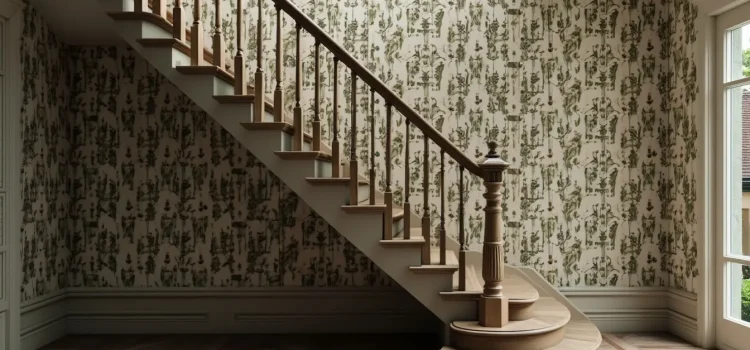
What hidden hazards have been lurking in our living spaces throughout history? How have seemingly innocent household features endangered families for centuries?
Homes have harbored numerous threats to our health and lives over time. In his book At Home, Bill Bryson explores the surprising dangers in the home that have plagued residents since ancient times—some of which continue to threaten our safety.
Read on to discover how everyday elements of your home might be part of a long tradition of domestic hazards.
Dangers in the Home
Even as people improved their health practices, they still had to navigate various hazards at home. Some are threats we deal with to this day. Bryson explores two major dangers in the home throughout history: staircases and wall coverings.
Stairs
Bryson suggests that stairs first appeared in Bronze Age mines around 3,000 years ago because workers needed to have their hands free to carry heavy loads—which they couldn’t do while climbing ladders. Although no one’s sure when staircases migrated into homes, staircases have been a major household safety hazard throughout history. Today, only car accidents cause more accidental deaths than stair accidents.
(Shortform note: Researchers found that even professionally designed stairs are risky, with at least 61% of stairways featured in an architectural journal having at least one visible design hazard. Dangerous stairs are so common that there’s a Facebook group dedicated to them. With nearly one million members, Death Stairs catalogs terrifying and hazardous staircases that members come across.)
According to Bryson, architects and engineers have tried to make stairs safer by developing mathematical formulas and careful measurements. However, creating perfectly safe stairs remains challenging because people climb up and down stairs differently. He explains that a staircase that feels comfortable to go up might be awkward or dangerous to go down, making every staircase design an imperfect compromise between these needs.
(Shortform note: Though a perfectly safe stair design still eludes us, you can make your stairs safer with a few changes: First, research shows that most falls happen because of slipping rather than tripping, so add grip materials like rubber treads, anti-slip tape, or tightly fitted carpet to your steps, especially if they’re made of smooth wood or tile. Second, improve the lighting by installing bright LED bulbs and switches at both the top and bottom of stairs, since most accidents happen at these points. Lastly, hard-to-see step edges also cause falls, especially for older adults, so add reflective tape or different paint colors to step edges to make it easier to see where each step ends.)
Toxins in Wall Coverings
Wall coverings were another source of danger in the home. Bryson writes that, for hundreds of years, people used toxic ingredients in wallpapers and paints that caused illness and accidents.
Bryson explains that wallpaper became affordable in the 1830s, transforming home decoration but also introducing new dangers. By the late 1800s, about 80% of English wallpapers contained a toxic substance called arsenic, especially in green colors. When walls became damp—a common problem in English homes—these papers released toxic fumes that made residents sick.
(Shortform note: Even after European scientists proved arsenic-based wallpapers were dangerous, British manufacturers ignored these warnings. William Morris, one of the most famous wallpaper designers of the time, denied the risks—perhaps because his father owned the country’s largest arsenic company. However, after newspapers spread awareness and consumers demanded safety alternatives, manufacturers stopped using arsenic by the late 1880s.)
Paint was also dangerous, says Bryson. For centuries, painters included toxic ingredients like lead, arsenic, and mercury compounds in paint, which led to a range of health issues including palsy, hallucinations, and even blindness. Another paint ingredient, linseed oil, caused many house fires because it could spontaneously combust. Despite people knowing about the dangers of lead, lead paint was only banned in the United States in 1978 and in Britain in 1992.
| Hidden Dangers in Modern Homes Although arsenic and lead are no longer used in paints and wallpapers today, harmful chemicals can still be found in modern living spaces. A class of chemicals called PFAS (per- and polyfluoroalkyl substances) can be found in everything from wall paint to carpeting to household dust. These “forever chemicals” remain indefinitely in the environment and our bodies, and they can lead to serious health issues including cancer, hormonal disruption, and developmental delays. Modern wall paint is one of many household items containing PFAS, with a study finding these chemicals in 60% of popular paint brands. The PFAS don’t just stay in the paint either; they can enter the air you breathe, similar to how Victorian paints and wallpapers released toxic fumes. Just as it took decades to ban arsenic wallpapers and lead paint despite known dangers, PFAS regulations have been slow to emerge. While the Environmental Protection Agency has only recently begun limiting certain PFAS in drinking water, companies continue to use these chemicals in countless home products. |






